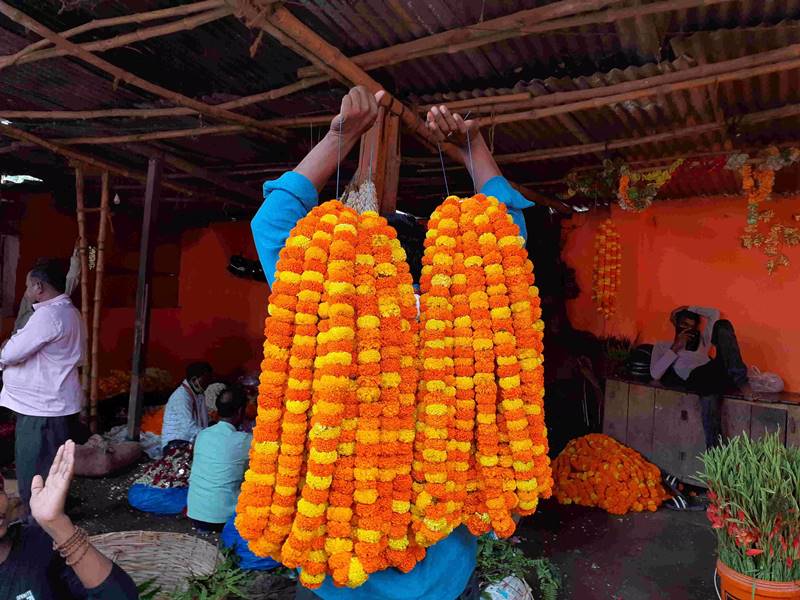After COVID, the stench of bad sales at the Varanasi flower market
For the second pandemic year in a row, those in the flower industry are wilting. Flowers provided a source of income for thousands of people in Varanasi, Uttar Pradesh. Of late, they struggle to make ends meet.

Varanasi, Uttar Pradesh
Flower seller Bablu, who operates out of Purvanchal’s biggest flower market in Varanasi, was surprised when the seller who sits next to him left his garlands with Bablu and left for home. “Sell these garlands and keep whatever you get. I am tired of sitting here since morning and not selling a single garland,” he told me, Bablu narrated to Gaon Connection.
“Our business has collapsed to the point where we face starvation. We cannot even recover costs, forget making a profit. Other than Corona, rain has also hit our business. Drenched flowers don’t get sold,” Bablu said.
Also Read: The shrinking world of Ghurni clay dolls
The floral business has crashed across the country as a result of the pandemic. This is the second year in a row that demand for flowers was less during the wedding season (March-May). Added to this, places of worship have also remained closed.
Those who grow flowers and everyone else in the business of flowers are wondering how to make ends meet. In many cities, a significant number of people are associated with the flower trade. Their source of income has dwindled or disappeared overnight. And one city where this is very visible is Kashi, also known as Varanasi.

From booming business to nothing
Varanasi, the city of ghats and bustling streets, boasts thousands of temples. In some places, every other home has a temple. Every day, flowers worth lakhs of rupees are used here. Now, that has come to a grinding halt.
“Temples and mosques have virtually been closed due to Corona rules. Though weddings are taking place, they are held with many restrictions. The money we earn these days is barely sufficient to buy dal and roti,” Sudama Devi, who sells garlands and flowers in Kisan Phool Mandi, told Gaon connection.
Also Read: Govt support boosts Varanasi’s wooden toy industry but workers’ woes remain
Sudama Devi, 46 years old, is a resident of Prime Minister Narendra Modi’s parliamentary constituency. “No government is taking our situation seriously,” she complained.
Flowers are decaying in large quantities at the Varanasi market due to lack of demand. They all find their way to the garbage bins.
Even in January last year, merchants in the kisan mandi did business of Rs 25 lakh every day. “Now, it is a meagre seven to eight lakh rupees,” said Vishal Dubey, manager. “The small traders in this area have gone out of business as a result of the temple’s near-closure. Even if temples are open for a short period, relatively few people visit, and the flower sellers near the temples suffer losses. It has become increasingly difficult for them to even meet their input cost,” he added.
Also Read: Varanasi’s boatmen await tourists; 4,000 manjhis have switched their traditional trade

From 280 to 40 quintals of flowers a day at Kashi Vishwanath temple
The volume of flowers used in the pre-pandemic era in the world-famous Kashi Vishwanath temple ran into more than 200 quintals. “The temple used to consume anywhere upto two hundred and eighty quintals of flowers a day. This has dropped to a mere forty quintals a day,” said Vishal Singh, secretary of the Varanasi Development Authority.
This reduction in business has affected labourers and gardeners who collect flowers from gardens and sell them to be converted into garlands. “The flower garland business is operating at approximately eighty per cent loss due to the Corona crisis,” explained 32-year-old Lalu Rajbhar, who has been selling garlands and flowers for the past 10 years.
Holding a garland of marigold flowers, he said: “We were barely surviving under Corona restrictions, and the rain has increased our misery. This is the first time in ten years that something like this has happened.” He said that feeding his family and educating his four children looked impossible.
Talking about the drop in the sale of garlands and flowers,” Rajbhar explained to Gaon Connection that it did not help that what was available was “too expensive”. “At present, temples are closed most of the time. No one orders a large quantity of flowers for weddings too. The mandi remains closed on Saturday and Sunday due to a weekly curfew. How will we earn?” asked Rajbhar, who hardly makes Rs 300 to Rs 400 a day, less than half of his pre-pandemic earnings.

Hub of business, now wilting
Traders from all over Purvanchal, including Gorakhpur, Deoria, Mau, Ghazipur, Jaunpur and Azamgarh, come to Varanasi’s farmers’ flower market to buy flowers and garlands. Marigold flowers were usually sourced from Kolkata.
“Our business has declined drastically since Corona restrictions were announced. Flower producers are unable to understand where to go and sell garlands and flowers, because the administration has relaxed restrictions for all markets except the flower market. Are only those who raise vegetables farmers? Those who grow flowers are farmers too,” 37-year-old Vishal Dubey, Kisan Phool Mandi manager, told Gaon Connection.
While the situation has seen some improvement, Dubey said “the efforts have not met even half of the traders’ list of expectations”.
According to the Union Ministry of Agriculture and Farmers Welfare report, in the year 2019-20, 323,000 hectares of aromatic and medicinal flowers were cultivated, and 3,000,000 metric tonnes were harvested.
According to the first advance estimate for 2020-21, the area under cultivation has decreased to 318,000 hectares, and production is estimated to be 2,793,000 metric tonnes.
The flower business is calculated both in weight and in numbers. Vishal Dubey said 20,000 to 25,000 marigolds, 15,000 to 20,000 tuberoses, 25,000 to 30,000 belas, and four quintals of roses are the usual items in demand on a daily basis. However, compared to the previous year, this year, just about 25 per cent of traders came to buy goods.

